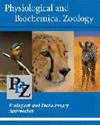冬眠蝙蝠的稀薄质量动力学及其对能源和水预算的影响
IF 1.8
3区 生物学
Q3 PHYSIOLOGY
引用次数: 2
摘要
冬眠需要在几个月内平衡能量和水的需求。许多研究已经注意到脂肪对冬眠能量收支的重要性,但冬眠中的蛋白质分解代谢受到的关注较少,并且以前没有考虑过整个动物瘦质量的变化。采用定量磁共振体成分分析方法,测定了洞穴肌炎(myotis velifer)冬眠前脂肪和瘦质量的沉积,以及汤森大耳蝠(Corynorhinus townsendii)冬眠期间脂肪和瘦质量的减少。对于洞穴肌炎,瘦体重占冬眠前体重增加的25%和38%(雌性和雄性分别)。在冬眠的汤森大耳蝙蝠中,雌性和雄性的瘦质量下降相似。我们使用Townsend的大耳蝙蝠的值来探索精益质量变化对水和能量预算的功能含义。瘦肉质量在冬眠期间的质量变化中占很大比例(雌性:18%,雄性:35%),尽管瘦肉质量分解代谢在能量预算中所占的比例不高(雌性:3%,雄性:7%),但对产水有重要贡献(雌性:14%,雄性:29%)。尽管由于排泄尿素的水成本,大多数哺乳动物不能依靠蛋白质分解代谢来产生代谢水,但我们提出了一种蛋白质换水策略的变化,即冬眠动物可以暂时将蛋白质分解代谢的好处划分为冬眠时期,而将水成本划分为定期醒来时通常可以获得免费饮用水。综上所述,我们的分析证明了考虑冬眠期间瘦质量变化的重要性。本文章由计算机程序翻译,如有差异,请以英文原文为准。
Lean Mass Dynamics in Hibernating Bats and Implications for Energy and Water Budgets
Hibernation requires balancing energy and water demands over several months. Many studies have noted the importance of fat for hibernation energy budgets, but protein catabolism in hibernation has received less attention, and whole-animal changes in lean mass have not previously been considered. We used quantitative magnetic resonance body composition analysis to measure deposition of fat and lean mass of cave myotis (Myotis velifer) during the prehibernation period and decreases in fat and lean mass of Townsend’s big-eared bats (Corynorhinus townsendii) during hibernation. For cave myotis, lean mass represented 25% and 38% (female and male, respectively) of prehibernation mass gain. In hibernating Townsend’s big-eared bats, lean mass decrease was similar for females and males. We used values for Townsend’s big-eared bats to explore the functional implications of lean mass change for water and energy budgets. Lean mass accounted for a substantial proportion of mass change during hibernation (female: 18%, male: 35%), and although not accounting for a large proportion of the energy budget (female: 3%, male: 7%), lean mass catabolism represented an important contribution to water production (female: 14%, male: 29%). Although most mammals cannot rely on protein catabolism for metabolic water production because of the water cost of excreting urea, we propose a variation of the protein-for-water strategy whereby hibernators could temporally compartmentalize the benefits of protein catabolism to periods of torpor and the water cost to periodic arousals when free drinking water is typically available. Combined, our analyses demonstrate the importance of considering changes in lean mass during hibernation.
求助全文
通过发布文献求助,成功后即可免费获取论文全文。
去求助
来源期刊
CiteScore
3.20
自引率
6.20%
发文量
62
审稿时长
6-12 weeks
期刊介绍:
Physiological and Biochemical Zoology: Ecological and Evolutionary Approaches primarily publishes original research in animal physiology and biochemistry as considered from behavioral, ecological, and/or evolutionary perspectives. Studies at all levels of biological organization from the molecular to the whole organism are welcome, and work that integrates across levels of organization is particularly encouraged. Studies that focus on behavior or morphology are welcome, so long as they include ties to physiology or biochemistry, in addition to having an ecological or evolutionary context.
Subdisciplines of interest include nutrition and digestion, salt and water balance, epithelial and membrane transport, gas exchange and transport, acid-base balance, temperature adaptation, energetics, structure and function of macromolecules, chemical coordination and signal transduction, nitrogen metabolism and excretion, locomotion and muscle function, biomechanics, circulation, behavioral, comparative and mechanistic endocrinology, sensory physiology, neural coordination, and ecotoxicology ecoimmunology.

 求助内容:
求助内容: 应助结果提醒方式:
应助结果提醒方式:


